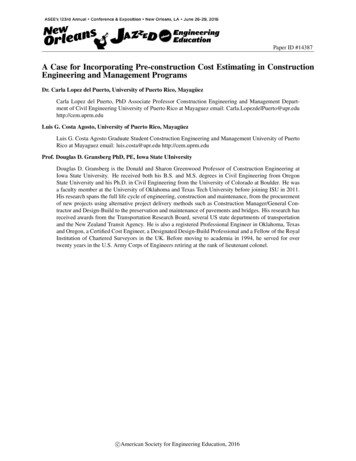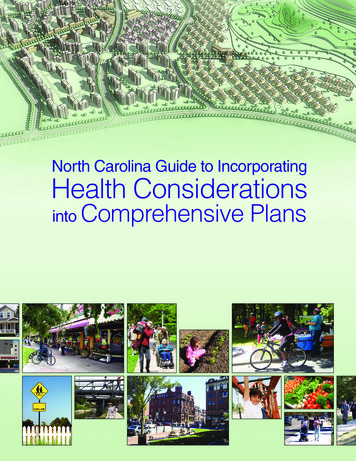
Transcription
Paper ID #14387A Case for Incorporating Pre-construction Cost Estimating in ConstructionEngineering and Management ProgramsDr. Carla Lopez del Puerto, University of Puerto Rico, MayagüezCarla Lopez del Puerto, PhD Associate Professor Construction Engineering and Management Department of Civil Engineering University of Puerto Rico at Mayaguez email: s G. Costa Agosto, University of Puerto Rico, MayagüezLuis G. Costa Agosto Graduate Student Construction Engineering and Management University of PuertoRico at Mayaguez email: luis.costa@upr.edu http://cem.uprm.eduProf. Douglas D. Gransberg PhD, PE, Iowa State UIniversityDouglas D. Gransberg is the Donald and Sharon Greenwood Professor of Construction Engineering atIowa State University. He received both his B.S. and M.S. degrees in Civil Engineering from OregonState University and his Ph.D. in Civil Engineering from the University of Colorado at Boulder. He wasa faculty member at the University of Oklahoma and Texas Tech University before joining ISU in 2011.His research spans the full life cycle of engineering, construction and maintenance, from the procurementof new projects using alternative project delivery methods such as Construction Manager/General Contractor and Design-Build to the preservation and maintenance of pavements and bridges. His research hasreceived awards from the Transportation Research Board, several US state departments of transportationand the New Zealand Transit Agency. He is also a registered Professional Engineer in Oklahoma, Texasand Oregon, a Certified Cost Engineer, a Designated Design-Build Professional and a Fellow of the RoyalInstitution of Chartered Surveyors in the UK. Before moving to academia in 1994, he served for overtwenty years in the U.S. Army Corps of Engineers retiring at the rank of lieutenant colonel.c American Society for Engineering Education, 2016
A Case for Incorporating Preconstruction Cost Estimating inConstruction Engineering and Management ProgramsThe need to effectively manage costs during the construction phase of a project to meet budgetconstraints is widely understood by both practitioners and academics. Most, if not all,Construction Engineering and Management undergraduate and graduate programs require thatstudents complete construction cost estimating courses as part of their core curriculum.However, the value of estimating the owner’s planning, design, and procurement costs during thepreconstruction period is not typically included in the Construction Engineering andManagement curriculum. Preconstruction costs are usually defined as all work required todevelop and advertise construction documents to a point where the construction contract can beawarded. Final project construction documents literally define the level of required constructionquality and as such, must also be of adequate quality to achieve the construction project’sultimate success. Thus, failing to provide an adequate and sufficient preconstruction budgetconstrains the necessary resources to fully develop these documents and may unintentionallyconstrain the document development process causing planners and designers to match their levelof effort to the amount of time permitted by the budget. Not only may the quality of theconstruction documents be negatively impacted but design factors of safety may be unnecessarilyincreased due to a lack of time to do detailed design analyses. It can also, eventually, have animpact in design issues related to serviceability, operation, or maintenance. Lastly, the increaseduse of alternative project delivery methods, such as Design-Build and Construction Manager-atRisk, have created a need to teach preconstruction cost estimating in academic programs toensure that graduates have the necessary knowledge and skills to effectively manage constructionprojects delivered using both traditional and alternative methods. This paper contributes to thebody of knowledge by demonstrating the importance of accurately estimating owner’spreconstruction costs and proposing a framework to assist engineering educators to integrate thesubject into the required curriculum in Construction Engineering and Management programs.IntroductionFrom an owner’s perspective, Preconstruction services (PCS) consist of all the work completedon the project from the conception through the contract award. It includes activities such asconceptual design, feasibility studies, preliminary engineering, and many other activities until theconstruction contract is awarded. Capstone courses are offered at most Construction Engineeringand Management programs in order to integrate and apply the knowledge gained during astudent’s academic degree. According to Gehrig et al., capstone courses “are usually structuredin a manner that requires student teams to design construction operational plans for realisticprojects” [1]. Often, the goal is for teams to mirror standard industry practices during thedevelopment of bid-level cost estimates, project schedules, etc. and allows students theopportunity to demonstrate and integrate the myriad of skills and knowledge learned over thecourse of the undergraduate curriculum” [1]. In capstone courses, students typically developconstruction documents for critical review by faculty and invited reviewers such as industryprofessionals [2]. Students are often asked to evaluate if their project is economically feasible. In
order to evaluate economic feasibility, students need to include costs for both the preconstruction and construction phases. Since cost estimating for the construction phase is taughtin most, if not all, construction engineering and management programs, students are able todetermine these costs using the knowledge they gained in prior courses that they have completed.However, when asked to estimate owner’s pre-construction costs, students often struggle becausethis topic was not adequately covered in their prior courses. The pre-construction costs thatstudents are asked to determine include but are not limited to the following: permitting costs,cost of surveying utility locations, environmental, geotechnical and other analysis as appropriate,preparing contract documents (conceptual, preliminary and final construction documents),advertising for bid, holding a pre-bid conference, receiving and analyzing bids, etc. [3]In the National Cooperative Highway Research Program (NCHRP) Project 15-51:Preconstruction Services Cost Estimating Guidebook, PCS are classified in four developmentphases [4], which are the following: Planning, Programming and Preliminary Design, FinalDesign, and Advertise and Bid, see Figure 1. The Planning phase consists in the determination ofthe project’s purpose and need, also the type of project, new or improvements. It is the phase toconsider environmental factors, facilitate public involvement and interagency conditions. Thefollowing phase is Programming and Preliminary Design in which the project’s scope of workdetails are defined. In this phase the environmental factors considered in the planning phase arefurther analyzed to obtain the environmental clearance. Furthermore, design criteria andparameters are determined leading to schematic developments, economic feasibility analyses,public hearings, preliminary plans and funding authorization. The next phase is Final Design.This phase consist in the development of plans, specifications and a more detailed cost estimatesbecause of the design completion. Finally, the last phase before construction is Advertise andBid. Contract documents, bid advertisements, pre-bid meetings are held in order to select thecontractor who will initiate the contract with the owner. After the mentioned steps, the ownerreceive and analyze bids, determine the lowest bidder and initiate contract. Almost all of theactivities related to each of the phases involve a certain level of expertise personnel who workseveral hours in order to design and develop a project for it to be constructed. Even though thequality and success of those activities that will result in a successful and efficient constructionproject is influenced by the quality of the PCS, the costs related to PCS are often overlooked.Figure 1 presents a PCS timeline and some of the activities related to each of the developmentphases.Figure 1: Preconstruction Services Timeline (Modified) [5]
The increase funding uncertainty and tightening of budgets in construction projects has resultedin scrutiny of every dollar spent in the construction phase of building and highway projects.While detailed estimates are routinely developed to estimate material, labor and equipment costsduring the construction phase, estimates of costs during the preconstruction phase are rarelyperformed. Gransberg et al, conducted a research study that analyzed the relationship betweenthe amount paid in the design phase to develop plans and specifications with the difference incosts between the engineer’s initial estimate of the project and the actual construction final costs[6]. The difference between these amounts is called “cost growth from the initial estimate”(CGIE). Traditionally, the metric used to determine cost growth in construction projects onlytakes into consideration the original construction contract award and the final contract costs. TheCGIE is an approach to measure if the amount of time and resources invested at the early stageof planning and design does make a difference in terms of decreasing the amounts ofdiscrepancies, errors and omissions, which eventually will trigger construction costs to vary fromthe original cost in the construction contract award. Therefore, the purpose of the research studywas to relate the “quality” of the design with the costs variations from the estimated project coststo the actual and final construction costs. CGIE results can be either positive or negative. IfCGIE is positive, it is an indication that the final construction costs surpassed the initialengineer’s estimate. Contrarily, a negative CGIE indicates that final construction costs were lessthan the original estimate. In this case, a negative CGIE is the evidence of inefficient use ofavailable capital in public works [7]. A construction project with a negative CGIE indicates thatmoney that could have been used in additional projects has been unintentionally withheld as acontingency against risks that were not realized. In other words, the project’s cost was overestimated. The CGIE metric depicts an ongoing problem in the construction industry between thequality of the planning, design and construction documents, and the eventual cost growth due topoor investment in these early and important stages.This research study [6] calculated the design fees as a percentage of construction cost and theCGIE as a percentage of the contract cost based on data from 31 projects worth 90 million fromthe Oklahoma Turnpike Authority (OTA). The projects were divided in two types, roads andbridges. The construction work in the majority of the road projects was related to roadwayconstruction, pavement, reconstruction, upgrade or rehabilitation. In terms of the bridge projects,the majority of the works were related to construction, reconstruction, rehabilitation or upgrade.A total amount of 13 road projects worth 63.6 million and 18 bridge projects worth 26.4million. The average design fee for those projects was 5.21% and the average CGIE was 9.65%6.When projects were divided into road projects and bridge projects, the results presented anotherreality. In road projects the average design fee was 1.96% and the average CGIE was 36.31%.For bridge projects, the average design fee was 7.61% and the average CGIE was -9.60%. Inorder to demonstrate the importance of properly estimating preconstruction costs it is importantto analyze and understand the correlation of the results from these projects. Based on theresearch study, the relation between the design fee and the cost growth is inversely proportional.In that case, a decrease in design fees leads to construction cost growth. The average design feefor road projects is lower than the average for the total amount of projects, but the CGIE isapproximately four times higher. This results can lead to the conclusion that the effect ofunderfunded designs can be higher construction costs. In terms of the bridge projects, the
average design fee is higher than the total average and the CGIE is negative. In this case, higherdesign fees lead to a negative construction cost growth. In a sense, a negative CGIE means thatthe adequate design was provided, but it also means that it was an inefficient use of funds, asmentioned before. Therefore, these results confirm the relation between design andpreconstruction costs and the consequences it has in terms of cost growth for the constructionphase.In times where faster is the norm, the quality in the development of construction documents havebeen compromised. A survey by the Construction Management Association of Americademonstrated that the “demand for increasing speed of project delivery is the top reason fordecline in construction document quality” [8]. Engineers have to fulfill owner’s needs andrequirements with less time and less resources resulting in plans and specifications withsignificant amount of missing information. The absence of important information in theconstruction documents leads to construction contract modifications, which increase constructioncosts. According to studies by Morgen (1986) and Kirby et al. (1988) 56% of all modificationsare directly related to design deficiencies [9, 10]. Therefore the studies found that the quality of aconstructed project is greatly influenced by the quality of the documents developed in thepreconstruction phase. Poor design quality leads to the need to correct design errors andomissions during the construction phase and has long been recognized as a cause of constructioncost and time growth [9, 10, 11, 12]. Burtati et al. found that on average poor design quality wasresponsible for adding 9.5% to the final contract amount [13]. Figure 2 presents the relationshipbetween the investment in design fees and the construction phase cost growth. It is evident thatto a point investing in the preconstruction design reduces the percentage of post-awardconstruction cost growth.Figure 2: Cost Growth relationship with Design Fees Investment 6In order to develop design solutions and produce drawings and specifications, designprofessionals (such as architects and engineers) typically charge by the hour. Traditionally, thetotal design services fee is calculated either as a percentage of anticipated construction costs orby square footage. Few owners appear to place importance of appropriately funding thepreconstruction phase and thus by estimating the design services fee using a percentage ofconstruction costs or by square footage, they inadvertently cap the design effort [4]. To estimatethe number of hours that design professionals can spend on a given project, architects and
engineers divide the total preconstruction budget by their hourly rate. If the amount of hours isnot enough to complete the design, design professionals must figure out how to complete thedesign while fulfilling their contractual and ethical obligation to the owner. Without sufficienthours to complete a design due to a tight hourly budget, design professionals often over-designthe project’s components [14]. For example, structural engineers can spend an adequate number ofhours designing a foundation to ensure that the footprint of the foundation is as small as possiblewhile meeting its functional requirement. If the structural engineers do not have enough hours todo a detailed design, they can increase the factor of safety, and thus increase the foundationfootprint, and still produce a design that is viable. Spending less time in developing the designsolution decreases the design costs but greatly increases the construction costs because thefoundation footprint is larger, thus needing more labor and material to be completed. Since thedesign costs are significantly less than the construction costs in any given project, saving moneyin the design phase may be counterproductive to the overall goal of decreasing project costs. Theobjective of this paper is to demonstrate the importance of accurately estimating preconstructioncosts and proposing a framework to assist engineering educators to integrate the subject into therequired curriculum in Construction Engineering and Management programs.Construction Cost CertaintyThe constructed project’s ultimate quality is defined during the preconstruction planning anddesign process [15]. Therefore, to prevent the escalating construction cost growth due tocorrections for errors and omissions in the construction documents, preconstruction servicesshould be properly funded. Accurate preconstruction services budgets should be established inorder to appropriately develop and quantify the project’s scope, considering the technical scopeand also the site-specific factors that have an impact in the technical design solution.Traditionally the PCS budget is calculated by, first estimating the project’s construction cost andthen multiplying it by a percentage that is based either on policy or on an average of historic PCScosts. The problem with this method is that the percentage used to calculate the budget is notspecific to the project’s scope and furthermore that construction costs change as projectdevelopment progresses. This can lead to underfunded preconstruction services which ultimatelycompromise the design, leaving the owner with poor construction documents due to inadequatefunding.Another typical approach at PCS is to deliver projects as inexpensive as possible, focusing oncost savings. According to the Crosset study, 82% of projects over 5.0 million overrun theirbudgets [16]. In addition to this study, as mentioned before, design deficiencies generate themajority of post-award contract modifications. This means that focusing on project cost savingshave been counterproductive. The idea should change from “minimize costs” to “maximize costcertainty”. Construction cost certainty is the result of adequately funded PC during planning,design and procurement process. PCS costs should be viewed as an investment, not anopportunity to diminish costs which eventually will result in poor design quality. Cost certaintycan be enhanced with the production of high quality construction and bidding documents. Theowner’s objective should be increasing cost certainty with the proper investment in thepreconstruction phase which will result in benefits such as better costs management through the
project lifecycle and the reduction of risks due to high quality construction documents. Thisconcept should be instructed as part of the solution for the construction cost growth problemmentioned before. Construction Engineering and Management programs should focus indeveloping the essential skills to identify, analyze, and accurately estimate preconstructionservices leading to cost certainty which will result in effective project management practices andsuccessful construction projects.MethodologyThe purpose of this study is to make a case for incorporating Pre-Construction Cost Estimatinginto the undergraduate and graduate Construction Engineering and Management curriculum.This study has the following two main research objectives:1) Investigate the current state of teaching Pre-Construction Cost Estimating in ConstructionEngineering and Management and Construction Management programs.2) Translate the results of industry based research to academia to adequately prepare ourstudents to estimate costs from the pre-construction phase of a project to the end of itslifecycle.In order to investigate the current state of teaching Pre-Construction Cost Estimating inConstruction Engineering and Management programs and Construction Management programs amulti-prong approach was used. The multi-prong approach consisted of an extensive literaturereview that included searching for journal articles and conference proceedings that discussteaching PCS. It also included searching through Construction Engineering and Management andConstruction Management program webpages to investigate the course offerings and reviewingcourse syllabi. The approach also included informal conversations with faculty who attended the2015 American Society for Engineering Education in Seattle, WA to investigate whether or notfaculty include PCS cost estimating in their graduate and undergraduate cost engineering andmanagement curriculum. Finally, case studies from construction projects were included tohighlight the complexity and need for estimating Pre-Construction costs in our industry. Thepurpose of including case studies from the industry in this paper is to translate the results ofindustry based research to academia to adequately prepare our students to estimate costs from thepre-construction phase of a project to the end of its lifecycle.Case Study MethodologyIn order to determine PCS estimating is currently performed by Construction Engineering andManagement professionals, a multi-prong approach was used. The multi-prong approachconsisted of an extensive literature review, interviews with cost engineering professionals andcase studies [16]. The results of the literature indicate that calculating a percentage of the total
costs is by far the most published and used method to estimate PCS costs. Information aboutother methods to estimate PCS was scarce.The next step was to develop a structured interview. According to the US GovernmentAccounting Office, structured interviews can be used where “information must be obtained fromprogram participants or members of a comparison group or when essentially the sameinformation must be obtained from numerous people for a multiple case-study evaluation” [17]Potential interviewees were contacted and ask for their consent to be interviewed. If potentialinterviewees agreed to the interview the structured interview questionnaire was provided to themand a date was selected for the interview. Providing the interview questionnaire prior to themeeting allowed interviewees to review it and ensured that interviewees had time to understandwhat they were asked and ask for clarification if needed. During the interview, interviewees wereallowed to digress which allowed for information was not initially contemplated in the structuredinterview questionnaire to be gathered,The last step in the multi-prong approach was to collect case studies using the three principlesdeveloped by Yin for research data collection:1.Use of multiple sources,2. Creation of a database, and3. Maintaining a chain of evidence [18].Interview findingsFrom the information gathered during the interviews with staff, the Office of Bridges andStructures at Iowa DOT determine the current state-of-practice in the development ofpreconstruction cost estimates. The preliminary design completion is the stepping stone toestimate the work effort hours to complete the final design. This is due to the fact that projecttype, size and location have been already determined at this stage. Instead of focusing theestimates on costs, in-house estimates focus on hours in order to balance the work load of designstaff determined by the engineering manager. The estimates of work hours rely greatly on theexperience of a senior engineer which leads to arbitrary budgets. To account for anunderestimate of hours due to project complexity the budgeted hours are adjusted at future targetmeetings. Even though the adjusted estimates are supposed to account for unexpected costs andallocation of resources, an insufficient budget is not identified until a substantial portion of theproject is already completed, which makes the adjustments irrelevant.In terms of outsourced designs, the engineering manager can influence the work effort budgetonly during negotiations. In this case, the consultant coordinator compares the estimates fromcompleted projects designs to estimate the project budget. Over-head and fixed fee costs areuseful in the determination of hourly costs of doing business for comparable projects. If there areno comparable projects, then the consultant use a factors approach. This approach requires anextensive professional experience due to the fact that the consultant estimator is assigning factorsbased on the perceived complexity of the project. In-house and outsourced methodologies arecompletely arbitrary.
Case StudiesIn order to validate the importance of estimating preconstruction costs, two case studies wereselected [4]. The Office of Bridges and Structures at Iowa DOT provided information on two finalbridge design projects that have been constructed. Although the information provided is onlyabout design, which is only one phase of the preconstruction services, it is sufficient todemonstrate how one major preconstruction function is estimated. Project 1 was completed by anexternal consultant designer and Project 2 by in-house designers. These approaches are useful toevaluate the effectiveness of the proposed estimation methods under both scenarios.The construction costs for both projects were 2.0M – 2.4M and the design for both was apretensioned prestressed concrete beam (PPCB) bridge. The preconstruction estimating methodsfor the case studies were compared based on the work effort hours only and were not convertedinto a final cost. Each case study involved two stages: Stage 1: collection of project scope information, the original preconstruction estimatinghours at the allocation of the project and the actual final preconstruction hoursStage 2: a return by the research team to Iowa DOT with a WBS to collect perceivedwork effort hours based on each individual work tasks.In stage 1, project scope information was gathered such as Type, Size and Location, preliminarybridge design and a copy of the final detailed bridge drawings to assess what design serviceswere provided for each project. It also consisted in interviews with the design staff that helpedthe research team to quickly grasp the main aspects of the preconstruction activities involved.In stage 2, the research team developed a WBS that could be used by both of the bridge designprojects to prove that standardization could be achieved even though different design approacheswere employed. One staff member completed work effort hour estimates for each project. Table1 demonstrates the work effort hours estimated and the actual hours for both projects.Table 1: Work Hours Estimates vs Actuals [4]Original DOT Estimate of HoursActual HoursProject 18811068Project 28002188As shown in the case studies presented, the original DOT estimated number of workhoursneeded to complete the pre-construction phase was significantly less than the number of hoursthat the consultant was able to negotiate. However, the consultant still underestimated thenumber of hours that it would take to complete the project by 23%. Project 2 was an in-houseproject where the original DOT estimated number of workhours needed to complete the preconstruction phase was significantly less than the actual number of hours needed to complete the
pre-construction phase (800 hours vs 2188 hours) which represent a 65% difference [4]. It isimportant to put those percentages in terms of money. In both projects, if the preconstructionservices were budgeted using the estimated hours by the experienced design estimators theywould have been underestimated, which leads to deficiencies and poor quality constructiondocuments. Therefore based on the results of the case studies, it is essential that designestimators and future construction engineering and management professionals have a betterunderstanding of how to accurately estimate pre-construction services. Based on the need toaccurately estimate PCS, this paper proposes the incorporation of PCS concepts and costestimate methodologies to undergraduate and graduate Construction Engineering ManagementPrograms. The following section presents and describes some of the topics related to PCS thatcan be included in a Construction Engineering Management curriculum.Proposed PCS CurriculumOne of the authors of this paper attended the 2015 American Society for Engineering Educationin Seattle, WA and asked in an informal conversation whether or not faculty include PCS costestimating in their graduate and undergraduate cost engineering and management curriculum.The authors also reviewed the syllabi for cost estimating courses that is available online atprogram websites and syllabi that was shared by faculty that the author personally knows. Basedon the results of the conversations and the review of course syllabi, the authors believe that valueof estimating the owner’s planning, design, and procurement costs during the preconstructionperiod is not typically included in the Construction Engineering and Management curriculum.This section outlines a proposed curriculum that can be included in current cost estimatingcourses or as a stand-alone course to assist engineering educators to integrate the subject into thecurriculum in Construction Engineering and Management programs. Table 2, includes theproposed topics and is followed by a description of each topic.Table 2: Proposed Preconstruction Topics for Construction Engineering and Management CurriculumTopicsPreconstruction Services (PCS) Definition Phases CostsTop-Down PCS Estimating Percentage Construction Costs Dollar Values Work Effort HoursBottom-Up EstimatingFunctional Level Estimating Process Work tasks and Work Breakdown Structure Level of Expertise Required Hours to work tasks Uncertainties
Top-Down PCS Cost EstimatingTo estimate preconstruction services costs for projects at early stages the most appropriateestimating method i
construction and construction phases. Since cost estimating for the construction phase is taught in most, if not all, construction engineering and management programs, students are able to determine these costs using the knowledge they gained in prior courses that they have completed. However, when asked











